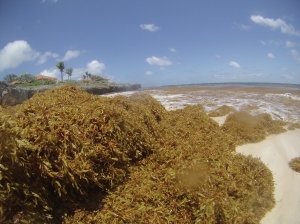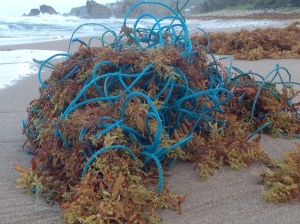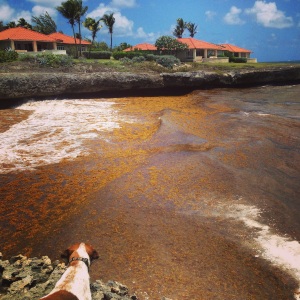Disclaimer: taken from my personal wordpress blog.
Sargassum: Who, What, Why, Where, When?
Sargassum
is a brown seaweed (moss) that is usually attached to the bottom of the
ocean but has gas filled berries that help it to float if ripped up by
wave action. There are many species, two of which never have contact
with the sea floor and live as free floating moss or in the case of
recent years, slicks or mats.
This
seaweed originally comes from the Sargasso sea in the North Atlantic
gyre. However, ongoing studies including satellite observations suggest
potentially new areas of origin & different sources such as the
mouth of the Amazon, an area that had not been previously associated
with the growth of this seaweed.
It
is not uncommon to see two of these species in the Caribbean but what
is alarming is the quantity beginning with the 2011 event. A lot is
still unknown stemming from the influx of pelagic sargassum onto the
coastlines of many Eastern Caribbean countries as well as West Africa
such as Ghana & Sierra Leone in 2011.
One
set of ocean currents come to the Eastern Caribbean from northern
Brazil, French Guiana, Suriname & Guyana and it is believed that the
Guyana current is responsible for transporting some of this moss into
the Caribbean whereas some is travelling in an equatorial
counter-current and reaching the West Coast of Africa (currents are some
amazing things!)
So
what does this sargassum mean for Barbados and the rest of the
Caribbean and Africa? There are both positive and negative impacts
associated with it. Some of these affect the fishing industry through
entangled lines & nets, clogging of engines as well as have negative
impacts through reducing light levels for fish. However, this seaweed
can provide habitat for juvenile fish & sea turtle hatchlings and
provides nutrients, supports food webs and acts as both a nursery &
spawning area.
In
Barbados in 2011, baby dolphinfish arrived earlier but the flying fish
season ended earlier and this is being voiced once again this year with
the price of flying fish apparently declining from $18 to $15 for 10
flying fish.
Another
major negative impact of this moss is the effect on the aesthetics of
our advertised pristine beaches for tourism. The moss gives off quite a
smell, which can be a bother for locals and tourists alike and has
resulted in expensive & often damaging and fruitless attempts at
removal.
So
many unanswered questions remain: why this increase and what is the
best way to utilize it and even profit from it? It may be linked to
above normal rainfall and thus run-off filled with nutrients in the
outflow of rivers.
Is
there enough to create a sustainable industry in the form of eating,
drinking, fertilizers, export? Perhaps if more people follow the lead of
Barbadian Mr.Callender and become more innovative, yes there could be a
market!
So
for now, why not pick up some, let the rainwater clean it and dry it if
using as fertilizer for those kitchen gardens while removing African
snails as well?!
Hope that you have gotten the drift on Sargassum!
(I must give credit to Hazel, who taught me much of this information.














